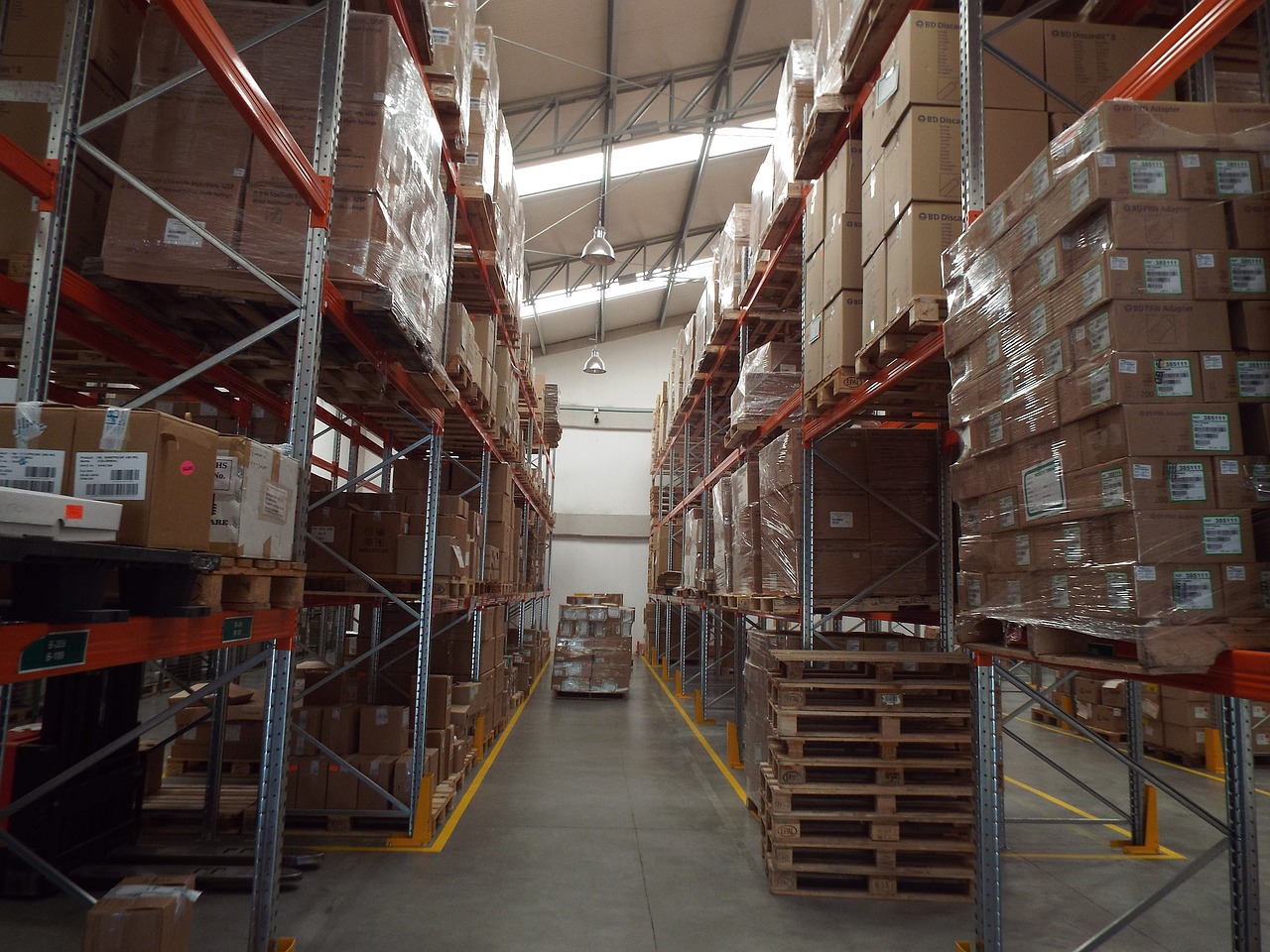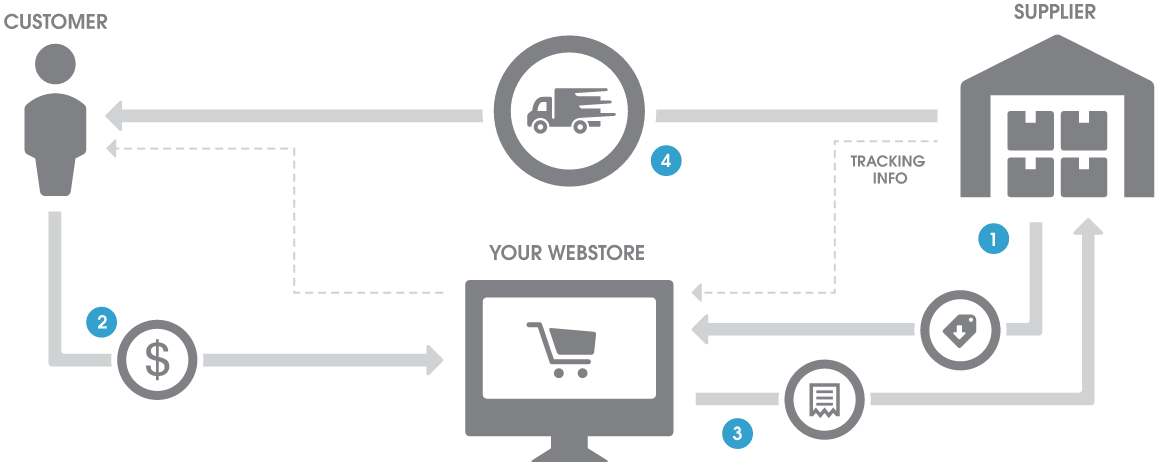We’ve covered in-house and just-in-time fulfillment, as well as outsourced fulfillment, each with its own positives and negatives, but now we’re moving to a completely hands-off form of fulfillment — dropshipping.
To some, it sounds like a pipe dream. No managing inventory? No actual fulfillment? That’s the essence of dropshipping, but there’s a lot more to it than that.
The Drop
Unlike the previous two models, the largest differentiators (and benefits) to dropshipping is the fact that you won’t be stocking inventory and you won’t be fulfilling. There’s no buying inventory from a supplier and storing it in-house or with a 3PL. With dropshipping, you’ll be working with suppliers to sell their products and that’s it. When an order arrives to your business, you’ll contact your supplier, purchase the product, and have them ship it out — something mighty appealing to e-retailers.
People say “you’re only as good as the people you keep,” and that phrase is no more true than with dropshipping. As a result, you’ll be relying heavily on your supplier for two of the most important parts of selling: the product itself and getting it to the customer. And that comes with some downsides as well.
Sell at the Drop of a Hat
Let’s start with the good stuff first.
Fulfillment tends to be a little complex and exhausting, especially if you’re learning the ropes. Because of that, dropshipping can be pretty attractive to just-starting-out ecommerce retailers. All of the glitz and glamor of online marketing without the baggage of fulfillment and inventory management is a dream come true. It means no storing expenses and none of the time-draining tediousness of picking, packing, and shipping orders.
Here’s a rundown of the bonuses it has to offer:
- No upfront, overhead costs — There’s no need to purchase inventory beforehand. You won’t need to rent a warehouse. Heck, you don’t even need a living room – you could run a dropshipping business from your car with an internet connection.
- It’s the epitome of outsourcing — Similar to outsourced fulfillment, your dropshipping supplier handles absolutely every aspect of getting orders from storage to customer. It’s also possible to leverage multiple suppliers at the same time depending on product catalog.
- Focus on sales and marketing operations only — Since the merchant has no part in fulfillment, their sole job is to focus on the sexier aspects to ecommerce, like sales, marketing, and customer relations.
- Easily test out new products — Merchants with their eyes on a new product but who are hesitant to buy up inventory can dropship to get an idea of the product’s viability without the financial risk of purchasing inventory.
It may seem attractive, but it has some clear-cut cons to be aware of.
The Constraints of Costs
As per usual, a key disadvantage to dropshipping is the cost. Suppliers will want to be compensated for their services, even if you’re buying products and selling for them. There are a few charges to be aware of that we’ll cover below.
There’s also a good chance that the supplier is selling through other channels and online retailers. That means the merchant is probably in price competition with other retailers, online or offline, who sell the same products, which in turn affects margins. Margins can be mighty slim in dropshipping, and the more merchants sharing the same supplier’s stock as you, the more likely a race-to-the-bottom will occur.
Control
This word has been thrown throughout every single model we’ve covered so far, and it’s no less important when dropshipping. Of all the fulfillment models, dropshipping offers the very least amount of control. The merchant has no control over the quality of the order when dropshipping. As opposed to the varying amounts of in-house or outsourced fulfillment, it’s completely hands off — the supplier deals with all things product and fulfillment related, not you.
As a result, it shares many of the same concerns as outsourced fulfillment. You might lose the opportunity to build your brand via packaging (ask your supplier if it’s possible), and you’ve limited control over when and how the package is delivered. Managing returns is a hassle as well. Should a returned order be going to the merchant or should it be returned to the supplier? In most cases, it’s the latter, preventing you from gaining direct insight into what went wrong.
Another biggie is lack of visibility into inventory. Because the product is stored away with the supplier, how are you to know what quantity is on hand so that demand can be met? Matters get even more complicated when you’re working with multiple suppliers, as you’ll need to know multiple, separate stock quantities. The remedies: syncing inventory with your sales channel via an integration, or an emailed count that you monitor on a spreadsheet.
Pick Your Partners Wisely
An area of risk when dropshipping is the very vendor you’re working with. Technically speaking, a merchant dropshipping is acting as a middleman between the vendor and the actual customer. The second you send a successful order over to the vendor, they’ve got a customer’s information. While it would definitely undermine their credibility amongst merchants, it’s perfectly possible for a supplier to cut a merchant out of the picture unless it’s specifically forbidden in a Negotiated Service Agreement (NSA).
On the same page, it’s critical that you vet the vendor’s fulfillment effectiveness in some way, whether in person or via reviews. Your relationship with suppliers is a mutual one that you both benefit from, but a poorly handled order shipment — whether it takes too long to reach the customer, or it arrives damaged — will impact your business and brand more than the actual vendor who’s invisible to the customer.
Your supplier-made-partner is important, so let’s talk about how you should go about picking one.
Your Partners
Let’s cover the supply chain first. As a dropshipper, you’ll be working with two potential suppliers, in most cases the latter; manufacturers or wholesalers.
Manufacturers are the very source of the product, the very people creating it. They do not sell directly to consumers. Instead, they sell in bulk to wholesalers or retailers large enough to purchase big quantities. By selling in bulk, they’re able to free up space for more products, have less cash tied up in inventory, and can offer cheaper prices to those that are buying.
Wholesalers will purchase in bulk from those manufacturers at cheaper prices, stock the product, and they sell it to retailers (such as a dropshipping merchant) at a markup.
You’ll be working with one of these two parties, so long as they’re willing to dropship their products. And that last part is big. Because you’re not handling inventory or fulfillment, you’ll only be able to dropship the products of manufacturers and warehouses that are expressly willing to do so. Some will only work with retailers looking to buy up a lot of inventory at once.
As you go about finding your significant supplier, ask yourself these questions to ensure they meet your demands:
- How will they take my orders — This is a big one, as quick communication is important when relaying orders to your supplier. Does the supplier accept forwarded email orders only? Do they require a call? Can they be integrated with your sales channels for automated routing? How exactly they communicate with you is pretty important, as we’ll touch on later.
- Are they located near my target market — You may not be shipping, but you’ll be paying for it. Selecting a supplier that’s near your customers will help reduce those costs. But an e-retailer oftentimes has no target market, so usually they’re looking for someone centrally located (think Kansas) to ensure 2 to 3 day delivery minimum across the country.
- Are they efficient — A no brainer, you’ll want a supplier that fulfills effectively and without error, especially if you want to prevent those returns. Merchant reviews of suppliers are big here.
- Can I get a look at the product and process — To be certain that their fulfillment quality is on par with your standards, check out the supplier’s facilities if you can. And, before even conducting business with them, ask for product samples if possible. If they try to charge you for them, that could be a red flag.
- Are they understanding and supportive — This is a relationship, but when we say understanding and supportive, we mean do they know their industry (whatever market their product’s in) and do they have dedicated reps to assist you if something comes up.
Finding suppliers is notoriously difficult, as they do a very poor job marketing themselves. But here are quite a few directories on the dropshipping scene that collect dropshipping wholesalers, manufacturers, and all of their products for easy discovery and access. Give them a look:
The Costs
Now for the important stuff: what you’ll be spending. Dropshipping doesn’t comes with quite as many costs as the other models — after all, you won’t have to deal with buying and storing all that inventory — but there are some critical expenses to be aware of.
Margins
Obviously, you’ll be purchasing dropshippable products from your suppliers. That’s the biggest cost. But, as most merchants understand, margins are what matters most, especially with dropshipping.
It’s all about product margins, and make no mistake, they’re slimmer than ever with such a model. You’re buying your product from a third-party, most likely a wholesaler that also bought it from a third-party manufacturer. It’s all a game of margins and markups. The balancing act is ensuring that your prices are affordable enough to get consumers buying, and high enough to have substantial margins. Pricing obviously depends on many factors, but product is what matters most.
To put it bluntly, margins can fluctuate wildly depending on the product, and, as many industry-leaders suggest, niches are the key. Choosing products to dropship could be a post in and of itself, but the gist is to choose a product that’s in a specific, narrow market. For example, basic electronics tend to have slim margins due to their availability everywhere. But something specific, like a remote-controlled toy boat, hell an entire site dropshipping remote-controlled products, is likely enough to a) separate you from a competitive market that bogs down prices and b) provide you with enough of a product-centered brand to warrant above-average prices that reap good margins.
And because it’s all about the product, your supplier is pretty important. Selecting one with affordably-priced, to-be-dropshipped products is a major factor. Usually your suppliers will be wholesalers, and they’ve purchased a ton of product from a manufacturer at a cheap price. Get an idea of how much the product is sold for by manufacturers to determine just how high the wholesaler has marked up the product.
Per-Order Fees
Suppliers will fulfill those orders for you, and that’s going to come at a cost. Like an outsourced fulfillment model’s 3PL, you can expect a fee for every order fulfilled. Once the supplier picks, packs, and ships the product, they’ll tack on a per-order cost that varies depending on packaging materials involved and the actual cost to ship the product. The per-order fee can range from $2 to $10, maybe even more if the product’s large or complex. It depends mostly on the product and where it’s being delivered.
Membership Fees
Those directories listed earlier that you can use to easily find suppliers and products? They’re going to charge you for their services. Some will charge based on monthly use, ranging from $25 to $100 depending on level of service, and others will charge for an entire year’s worth of access, which could be anywhere between $200 and $1,000 depending on services rendered.
Fair warning, though. If a wholesaler or manufacturer (not a directory, which collects wholesalers and manufacturers’ products in a single place for easy access) is trying to charge you a membership fee, that may be a red flag. An e-retailer and dropshipping supplier work together for mutual benefit. Charging the merchant for the privilege of doing business is a sign of either a money-gouging partner or a scam.
Minimum Orders
Some of those dropshipping suppliers will require minimum orders before working with you, and, although it isn’t a cost, it’ll have some financial repercussions.
Minimum orders are partially made to ensure that an e-retailer means business; they have every intention of using the supplier to dropship a substantial amount of orders. But keep in mind these suppliers are sitting on a lot of product that they prefer getting rid of in bulk (a wholesaler already bought it in bulk to begin with). Fulfilling smaller orders is more expensive, and that’s unsustainable for a business that bought a ton of product at lower prices.
Here’s an example of how it can impact your process. What if your supplier demands minimum orders of $100 or more, but your average order hovers around $40? Well, let’s hope you have confidence in your selling abilities. What you’ll normally have to do is pre-pay the supplier that $100 as credit, paying it off as you sell their products and rake in some revenue from margins.
This can irritate some e-retailers, because it’s vaguely similar to buying inventory, something many dropshipping merchants are expressly trying to avoid. Buy purchasing products without orders at-the-ready, you’re essentially tying up your cash in inventory until orders arrive. That’s why it’s very important to pick suppliers that meet your needs as an e-retailer. Your relationship is everything.
Walkthrough
OK – with all of that out of the way, here’s a recap of how the fulfillment model functions, referencing our graphic above. It’s relatively straightforward:
1. Partner with suppliers — When dropshipping, relationships are everything (I’m sure the phrase is getting old). The dropshipping suppliers you choose will inevitably be based on the products they carry.
2. Sell their products — Your job as a dropshipping e-retailer is to effectively market and sell the supplier’s products. No fulfillment for you. Just sell it by branding, content and SEO marketing… you get the point.
3. Route your orders to your suppliers — There are a few ways to route orders, and they’ll usually depend on the supplier’s preference; phone call, email, or integration.
- Phone call — Straightforward, you’d call your supplier to let them verbally know of the order specifics. It’s not exactly efficient, it’s a little archaic, but it’s out there.
- Email — The most common form of routing is through email. A merchant processes an order on their sales channel, and forwards the order information to their supplier who receives and fulfills it. Once that’s done, the supplier then sends back the order’s tracking info to the merchant who then hands it over to the customer to keep track of their order.
- Integration — A potentially expensive and automated way of routing orders is by building an integration between a sales channel or order management system (a tool that helps manage multiple sales channels in one place) and the supplier. It’ll usually cost you a sum, but it means every order made on any sales channel automatically makes its way to the supplier for fulfillment without the need for manual work. Once fulfilled, tracking info can then be relayed back to you.
4. Suppliers fulfill dropshipped orders — Self-explanatory, the supplier takes your order and ships them out to the customer.
With that wrapped up, it’s clear that, like any of the other fulfillment models, there are some pros and cons with dropshipping. Lower expenses and less responsibility come at the cost of less control, more reliance on suppliers, and potentially weaker margins. Regardless, there’s no doubt: it’s an appealing model for many merchants, especially those with no interest in backend operations.






